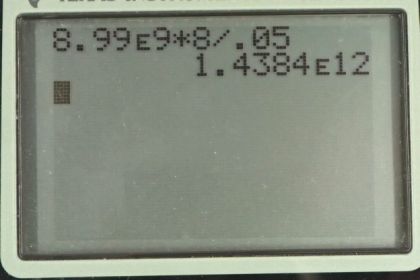Question
(a) Find the voltage near a 10.0 cm diameter metal sphere that has 8.00 C of excess positive charge on it. (b) What is unreasonable about this result? (c) Which assumptions are responsible?
Final Answer
- This is unreasonably high. Sparks would fly through the air since the dielectric strength of air is
- The sphere can not accumulate of charge.
Solution video
OpenStax College Physics for AP® Courses, Chapter 19, Problem 11 (Problems & Exercises)

vote with a rating of
votes with an average rating of
.
Calculator Screenshots
Video Transcript
This is College Physics Answers with Shaun Dychko. We have a sphere of diameter ten centimeters, and we’re asked to find the voltage near this sphere. Now it doesn’t really say what the distance should be, it just says near it, and let’s assume that we’ll get as near as possible, which will be a distance, which is a radius of 0.05 meters, so basically on the surface. So the potential due to a point charge, which is what this sphere basically is, is the Coulombs constant times the charge divided by the distance from the center of it. So that’s 8.99 times ten to the nine newtons meter squared per Coulombs squared, times eight Coulombs divided by 0.05 meters, which is 1.44 times ten to the 12 Volts. This is an unreasonable number because the dielectric strength of air is three times ten to the six Volts per meter, which means if you’re one meter away from something with this voltage, then sparks will automatically fly through the air connecting the two things. And this voltage is really really high, and so it’s ten to the six times bigger than this, it’s a million times bigger than this dielectric strength, so we would expect sparks to fly so nothing can have this voltage when it’s in the air otherwise sparks will fly. So we have to say that it’s unreasonable to think that this sphere has eight Coulombs of charge. That’s not a realistic number.
